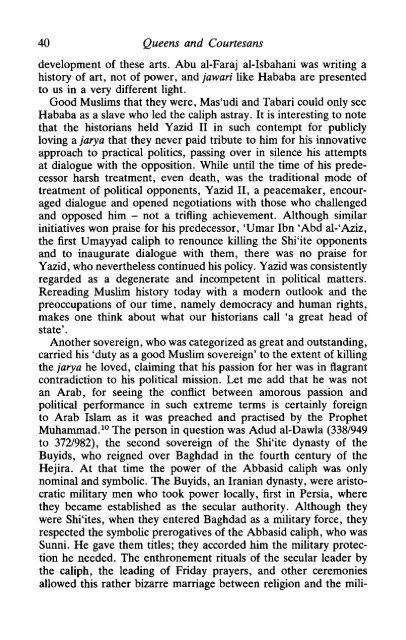Fatima.Mernessi_The-Forgotten-Queens-of-Islam-EN
Fatima.Mernessi_The-Forgotten-Queens-of-Islam-EN
Fatima.Mernessi_The-Forgotten-Queens-of-Islam-EN
Create successful ePaper yourself
Turn your PDF publications into a flip-book with our unique Google optimized e-Paper software.
40 <strong>Queens</strong> and Courtesans<br />
development <strong>of</strong> these arts. Abu al-Faraj al-Isbahani was writing a<br />
history <strong>of</strong> art, not <strong>of</strong> power, and jawari like Hababa are presented<br />
to us in a very different light.<br />
Good Muslims that they were, Mas'udi and Tabari could only see<br />
Hababa as a slave who led the caliph astray. It is interesting to note<br />
that the historians held Yazid II in such contempt for publicly<br />
loving a jarya that they never paid tribute to him for his innovative<br />
approach to practical politics, passing over in silence his attempts<br />
at dialogue with the opposition. While until the time <strong>of</strong> his predecessor<br />
harsh treatment, even death, was the traditional mode <strong>of</strong><br />
treatment <strong>of</strong> political opponents, Yazid II, a peacemaker, encouraged<br />
dialogue and opened negotiations with those who challenged<br />
and opposed him - not a trifling achievement. Although similar<br />
initiatives won praise for his predecessor, 'Umar Ibn 'Abd al-'Aziz,<br />
the first Umayyad caliph to renounce killing the Shi'ite opponents<br />
and to inaugurate dialogue with them, there was no praise for<br />
Yazid, who nevertheless continued his policy. Yazid was consistently<br />
regarded as a degenerate and incompetent in political matters.<br />
Rereading Muslim history today with a modern outlook and the<br />
preoccupations <strong>of</strong> our time, namely democracy and human rights,<br />
makes one think about what our historians call 'a great head <strong>of</strong><br />
state'.<br />
Another sovereign, who was categorized as great and outstanding,<br />
carried his 'duty as a good Muslim sovereign' to the extent <strong>of</strong> killing<br />
the jarya he loved, claiming that his passion for her was in flagrant<br />
contradiction to his political mission. Let me add that he was not<br />
an Arab, for seeing the conflict between amorous passion and<br />
political performance in such extreme terms is certainly foreign<br />
to Arab <strong>Islam</strong> as it was preached and practised by the Prophet<br />
Muhammad. 10 <strong>The</strong> person in question was Adud al-Dawla (338/949<br />
to 372/982), the second sovereign <strong>of</strong> the Shi'ite dynasty <strong>of</strong> the<br />
Buyids, who reigned over Baghdad in the fourth century <strong>of</strong> the<br />
Hejira. At that time the power <strong>of</strong> the Abbasid caliph was only<br />
nominal and symbolic. <strong>The</strong> Buyids, an Iranian dynasty, were aristocratic<br />
military men who took power locally, first in Persia, where<br />
they became established as the secular authority. Although they<br />
were Shi'ites, when they entered Baghdad as a military force, they<br />
respected the symbolic prerogatives <strong>of</strong> the Abbasid caliph, who was<br />
Sunni. He gave them titles; they accorded him the military protection<br />
he needed. <strong>The</strong> enthronement rituals <strong>of</strong> the secular leader by<br />
the caliph, the leading <strong>of</strong> Friday prayers, and other ceremonies<br />
allowed this rather bizarre marriage between religion and the mili-


